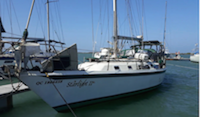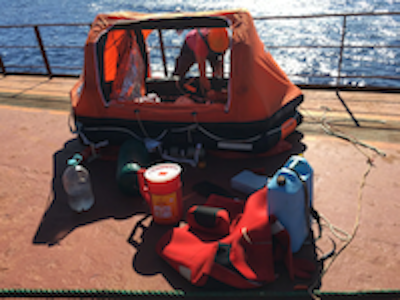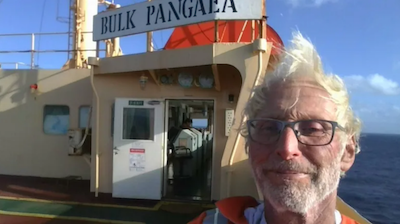Cuba: Canadian Sailor Rescued after Five Days Adrift in Life Raft
A Canadian sailor survived on chips, crackers and a handful of small fish during nearly six days adrift in a small life raft, after his yacht hit a reef and sank off the south-west coast of Cuba.
Published 3 years ago


- The Starlight II, purchased by Don Cavers.
Don Cavers’ misadventure started in November 2021 when he flew to Colombia to pick up a sailboat he had purchased sight unseen. Not long after setting sail for Puerto Rico on December 2, 2021, he ran into trouble off the coast of Colombia.
“The boat seemed a little sluggish, so I took my headlamp and took a look down below and discovered I had three inches [eight centimetres] of water over the floorboards … it turned out that every hatch in the boat was spraying water,” Cavers told the CBC News website.
He managed to bail out most of the water, but within 36 hours, the salt had destroyed most of the boat’s electrical systems. For the next two days, he said he hand-steered the ship for 16 to 18 hours straight before managing to get his autopilot working on the morning of December 7.
After spending the next day and a half trying to fix his other equipment and only taking short breaks to sleep, Cavers said he must have fallen asleep at a very inopportune time.
“I woke up to a very heavy bump and found myself bouncing on a reef … the keel caught and probably tore the stern open because the boat started sinking pretty quickly,” he recalled.
Life-saving Supplies
As the boat sank, Cavers said he was able to grab a few things that would end up being key to his survival — a working computer, his bag filled with life-saving supplies, including flares and a signal mirror, a bag of nacho chips and a package of crackers, a waterproof backpack with his identification, a 20-litre container of water and his personal locator beacon.


- The life raft in which Don Cavers spend nearly six days adrift off the coast of Cuba. (c) Don Cavers.
Three days after the wreck, Cavers managed to get his locator beacon broadcasting. It sent a satellite message to an international network, including the Canadian Mission Control Centre and the Joint Rescue Co-ordination Centre in Trenton, Ontario. Both organizations are a part of Canada’s national search and rescue operations.
Those teams worked to identify who the beacon belonged to and convince other officials to check out the source of the satellite pings, said Capt. Brian Bowen, duty operator with the Canadian Mission Control Centre.
US Coast Guard Alert
Ultimately, it was an alert sent out by the U.S. Coast Guard that resulted in the sailor’s rescue, thanks to a merchant ship called the Bulk Pangea, which volunteered to help.


- Don Cavers aboard his rescue ship – the Bulk Pangaea (c) Don Cavers
Cavers was lying in his raft about halfway between Cuba and the coast of Mexico’s Yucatán Peninsula on the afternoon of his sixth day in the liferaft, when he heard the blast of a ship’s horn.
“Usually when you’re in a sailboat and a ship is blowing his horn, it means get out of your way,” Cavers said. “But I’m in a liferaft and can’t get out of the way, so I immediately unzipped and fired a couple of flares up and grabbed the radio to let these guys know that, ‘Hey, I can’t get out of your way,’ and they said, ‘Oh no… We’re here to rescue you.’
Cavers was rescued on December 14, 2021 after setting sail from Colombia on December 2. The full story of his rescue can be read on the following link:
………………………………………………………………………………………………………………………………………
Noonsite has not independently verified this information.
Related to following destinations: British Columbia, Canada, Colombia, Cuba, Puerto Rico
Related to the following Cruising Resources: Incident Reports, Safety, Safety and Medical





